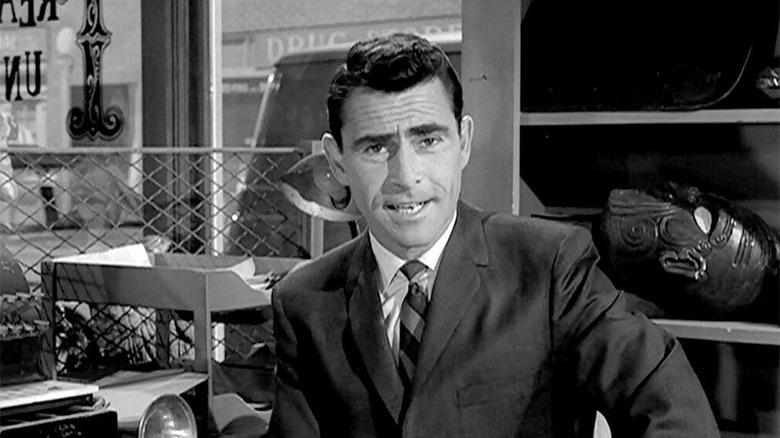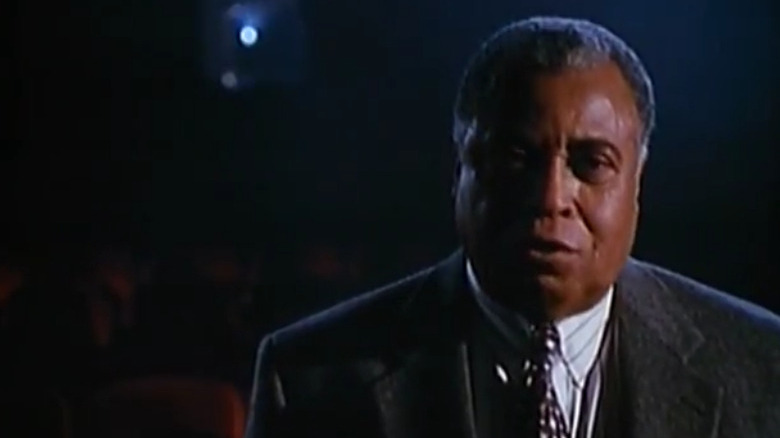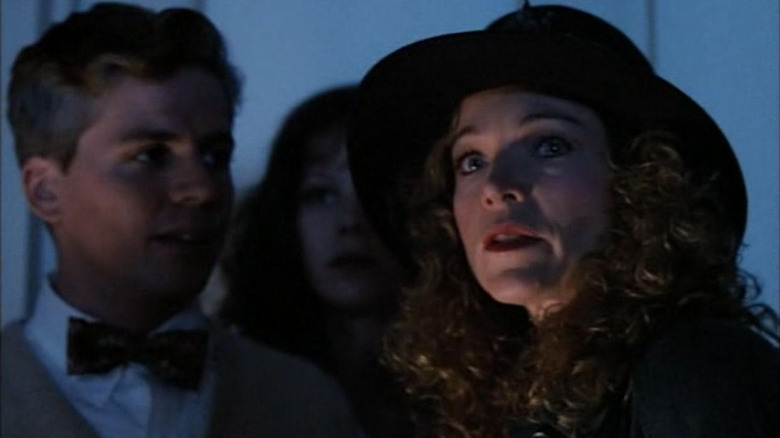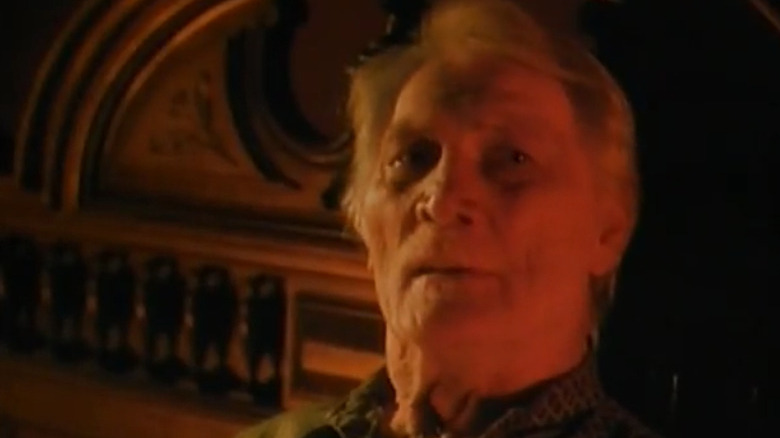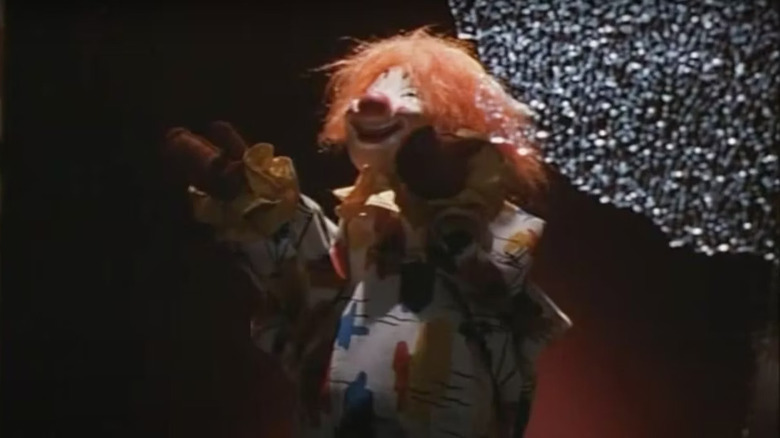There Was A Second Twilight Zone Movie That You've Probably Never Heard Of
There have been movies based on TV shows almost as long as there have been TV shows. Even in the 1950s, the first decades where large numbers of Americans owned a TV set, hit crime series like "Dragnet" and "The Lineup" made their way to theaters, alongside hit comedies like "Our Miss Brooks." Even TV movies got the fancy big-screen remake treatment, with the 1953 teleplay "Marty" not only getting a feature-length movie adaptation two years later, but also winning the Academy Awards for Best Picture and Best Actor, and the prestigious Palme d'Or at the Cannes Film Festival.
While some TV shows, even those popular enough to get their own movie, wind up forgotten, the big ones usually stick around in the public consciousness. Rod Serling's award-winning anthology series "The Twilight Zone" wasn't just a hit, it became something of an institution. It was an instantly recognizable brand, with episodes still quoted in the mainstream decades later, and a series of notes in the theme song which have been become indelibly linked with concepts that are strange or otherworldly. The show was a big hit, and the 1983 movie is well-remembered today, in part for its memorable re-stagings of classic episodes from filmmakers like Steven Spielberg, Joe Dante, and George Miller, and tragically, for the horrible events that transpired behind the scenes.
But despite the lingering popularity of "The Twilight Zone," and the fact that the first film made money, leading to a long-running TV revival in the 1980s, and still despite even being rebooted within the last few years by Oscar-winning horror filmmaker Jordan Peele, there's another movie based on Rod Serling's hit series that has flown almost completely under the radar. And it was written (mostly) by Rod Serling himself.
Twilight Zone: Rod Serling's Lost Classics
Rod Serling was a prolific writer. In addition to scripting 92 of "The Twilight Zone's" 156 episodes, he also wrote 50 episodes of "The Night Gallery" and co-wrote the screenplay for the original "Planet of the Apes." Considering how many screenplays Rod Serling got made it's hard to imagine that there were any left over but in 1994, nearly 20 years since Serling's death, his widow Carol Serling found two more scripts in a trunk in their garage.
Those scripts were brought to life in the TV movie "Twilight Zone: Rod Serling's Lost Classics," directed by Robert Markowitz ("The Tuskegee Airmen"). The anthology film was hosted by James Earl Jones, who had previously starred in the 1972 drama "The Man," written by Serling, about the first Black president of the United States. Jones's deep, impressive voice gives his narration more heft that Serling's host segments from the original series, but they go a long way towards making the last two "Twilight Zone" episodes feel important.
And they really needed that boost, because whether you think of "Rod Serling's Lost Classics" as an anthology feature or the final two episodes of the original "Twilight Zone," they're not particularly great.
The Theatre
"The Theatre" was based on an outline by Rod Serling, and completed by frequent "Twilight Zone" contributor Richard Matheson ("Nightmare at 20,000 Feet"). The half-hour segment stars Amy Irving ("Yentl") as Melissa, a sculptor whose boyfriend James (Gary Cole, "Office Space") wants to marry her. She isn't interested in a serious commitment, but she does get annoyed when he has to work during their long-planned date to see "His Girl Friday" at a local film festival.
Melissa attends on her own and is surprised to discover that the film also features scenes from her own life, specifically her last few conversations with James. She assumes it's some kind of a practical joke, since James is a bit of a kidder, but nobody else can see those scenes. And weirder still, they don't just play moments from her past ... they also show her images of his own death, in just a few days' time.
The idea of a movie theater that shows you scenes from your own life is fanciful, top-drawer "Twilight Zone" material. The execution simply isn't. "The Theatre" works overtime to highlight scenes of Cary Grant and Rosalind Russell debating over their own love life in "His Girl Friday," but the story isn't terribly interested in Melissa and James's relationship. It's not about her fear of commitment, or even about viewing her own life from the point of view of an audience member with a little distance. It quickly devolves into a straightforward tale of whether or not she's going to die the way her visions say she will, which is clumsily presented and thematically disconnected from everything else about the story. It feels like a "Twilight Zone" episode, certainly ... just not one of the good ones.
Where the Dead Are
The second, hour-long segment in "Twilight Zone: Rod Serling's Lost Classics" doesn't feel like a "Twilight Zone" episode at all. It's got a fantastic premise, about a doctor who uses a mysterious formula to keep all the people in his village alive after they die, but the execution has a lot more in common with a Hammer horror film than anything else. (Then again, this script was written in 1968 — four years after the cancellation of the series — so even though it takes up the bulk of this "Twilight Zone" movie, it was probably never intended to be an official part of the show.)
"Where the Dead Are" stars Patrick Bergin ("Sleeping with the Enemy") as Dr. Benjamin Ramsey, who investigates a medical mystery shortly after the American Civil War. He has failed to save the life of a man who, due to his massive head wound, should have died years ago, and travels to his isolated home town to interview a disgraced physician, Dr. Jeremy Wheaton (Oscar-winner Jack Palance, "City Slickers"), who may have the answers.
Dr. Wheaton tries to hide the truth, but eventually he confides that he found a cure for death, and has been using it on the townsfolk for many years. But in return, they cut off his legs and kept him prisoner, because only he knows the secret to keeping them alive. Now dying, Wheaton's last act has been to replace their life-giving medicine with a placebo, and now a horde of rotting zombies has started attacking his house, ready to kill Wheaton, his niece, and Dr. Ramsey.
This final segment is atmospheric, and Palance chews his many mad scientist monologues with relish, but it lacks the irony that comes part and parcel with most "Twilight Zone" episodes. It's a classical horror tale, and not a bad one, but it just can't help but feel out of place in the franchise.
Last stop, The Twilight Zone
"Twilight Zone: Rod Serling's Lost Classics" aired on CBS on May 19, 1994, just one day before the theatrical release of Richard Donner's "Maverick," another movie based on a TV series that aired in the early 1960s. It has never been released on home video in the United States, and despite the film's association with a beloved franchise and some noteworthy talent involved, it remains frustratingly obscure. It may not be the best "Twilight Zone" ever but it's still the "Twilight Zone," dang it, and people should be able to find it without resorting to inferior VHS rips on the internet.
"The Twilight Zone" endures, of course, but as far as films go it's been a long time since anyone tried to adapt Serling's work for the big screen, or even on the small screen at feature length. Weirdly enough, however, "Rod Serling's Lost Classics" isn't the final "Twilight Zone" movie. There was one more, a film that's just as obscure if not more so.
But that, perhaps, is an article for another time ...
